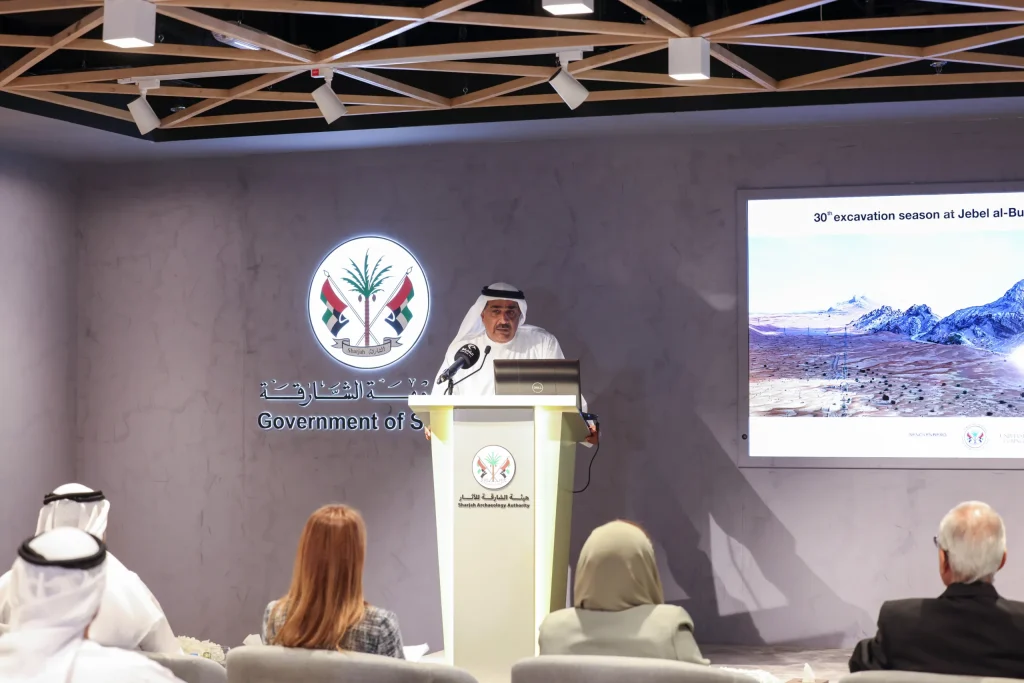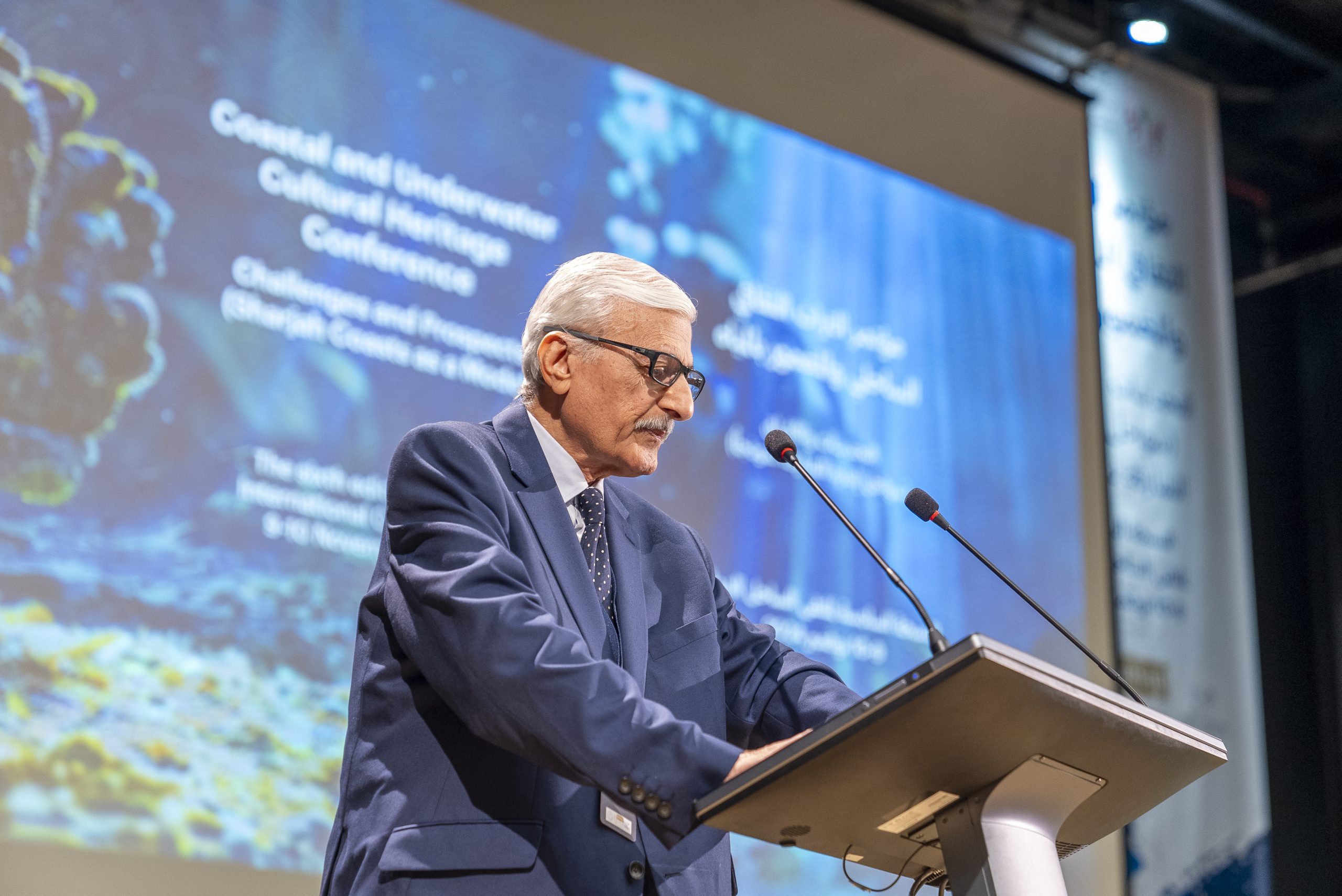In conjunction with the 30th excavation season at Jebel Al Buhais and Jebel Faya, organized by the Sharjah Archaeology AuthorityBodour Al Qasimi witnessed the scientific symposium on Landscape archaeology, paleoenvironments, human adaptations and dispersals in the Arab RegionSheikha Bodour bint Sultan Al Qasimi, Chairperson of Sharjah Investment and Development Authority (Shurooq) witnessed the proceedings of the scientific symposium organised by the Sharjah Archaeology Authority (SAA) on (Saturday) at the SAA’s headquarters. The event was attended by His Excellency Eisa Yousif, Director General of the Sharjah Archaeology Authority, His Excellency Dr. Sabah Aboud Jasim, advisor to the Sharjah Archaeology Authority, and His Excellency Mubarak Al Nakhi, Undersecretary of the Ministry of Culture, and a number of guests from outside the UAE from the Kingdom of Saudi Arabia and Oman.The symposium featured a select group of officials from the SAA, UNESCO Office for Egypt and Sudan, archaeologists, academics, and researchers from within the state and Germany, Britain, France, and Sudan. It was a collaboration between the SAA, the University of Tübingen in Germany, and the Senckenberg Society for Natural History, commemorating the 30th excavation season at Jebel Al Buhais and Jebel Faya in Sharjah. The theme for this 30th season is “Landscape archaeology, paleoenvironments, human adaptations and dispersals in the Arab Region”. The research discussion sessions took place on February 24 and 25.Enrichment of Archaeological ActivityAt the beginning of the symposium, His Excellency Dr Sabah Aboud Jasim delivered a speech in which he expressed his thanks and gratitude for the presence of Sheikha Bodour bint Sultan Al Qasimi at the event, reflecting the wise leadership’s interest in documenting and protecting the archaeological importance of various areas in the UAE. It represents qualitative support for the role of the SAA in enriching and preserving Sharjah’s archaeological activity, enhancing its archaeological identity, and spreading awareness of its cultural, material, and civilisational heritage both locally and globally.A Rich History for the cultural heritage of the Emirate of SharjahHis Excellency Eisa Yousif, Director General of the Sharjah Archaeology Authority, affirmed that the SAA strives to conduct specialised scientific studies in research and excavation of archaeological sites throughout Sharjah. This includes the inventory and documentation of essential discoveries and rock inscriptions through researchers and archaeologists specialized in excavation, preservation, and documentation. It also includes organizing major scientific conferences and symposia to safeguard the rich history of the cultural heritage of the Emirate of Sharjah and its people. This is a history of considerable depth evident in its antiquity, as these studies and ongoing field research indicate that humans have settled many sites in the state in general and in the Emirate of Sharjah in particular. Sharjah houses the oldest known human site in the Arabian Peninsula, the rocky site at Jebel Faya in the Mleiha archaeological area, which was recently included in the tentative list for UNESCO World Heritage Sites. This contributes to highlighting the history of the state by recognizing its cultural value and archaeological importance on a global level, in addition to sites like Jebel Al Buhais and other archaeological sites in Sharjah.Field Studies and Significant ResultsThe agenda of the scientific symposium included a paper by His Excellency Dr Sabah Abboud Jasim, advisor to the Sharjah Archaeology Authority, about the archaeological heritage and cultural landscape of the central region in Sharjah, followed by a joint review by Dr Sabah Jasim and Nicholas Conard from the University of Tübingen in Germany. In their review, they discussed important observations regarding the research legacy of Professor Dr Hans-Peter Uerpmann in Sharjah. Dr. Sabah Aboud Jasim’s presentation explained that Jebel Faya is located in the Emirate of Sharjah, specifically in the Mleiha region, and is considered one of the most important Paleolithic sites in the Arabian Peninsula. Archaeological excavation conducted in 2009 revealed a human settlement dating back to 125,000 years ago, making it the oldest known human site in the Arabian Peninsula. New archaeological data from Jebel Faya, published in scientific reports, indicate that human settlement in southern Arabia occurred under unexpected climatic conditions far earlier than previously thought. The team used a sophisticated array of archaeological, ancient climate, and dating technologies to reconstruct four distinct phases of human settlement between 210,000 and 120,000 years ago. This decisively demonstrates that humans settled the site during both dry and wet climate conditions – challenging previous ideas about when and under what circumstances humans could have settled Arab sites during the Paleolithic period and opening up the possibility that the Arabian Peninsula may provide more evidence on human migration out of Africa during periods of drought.Archaeological Discoveries at Jebel FayaThe symposium included discussions on the archaeological discoveries at Jebel Faya, where many findings indicate the site was a crossroads and inhabited by humans from different continents during the Stone Age. This mountain is surrounded by a wealth of stone tools, where numerous excavations have left behind a collection of discoveries at the Jebel Faya site in addition to the FAY- NE 1 site, which is one of the most important archaeological sites in Jebel Faya for its prominent discoveries. These findings have proven the site’s significant importance locally and globally, as the mountain holds excellent significance in illustrating the early human migration history that is subject to much debate.The presentation also covered the discovery of white limestone flakes in the area. This led to conclusions about the climate of that region thanks to traces of calcium carbonate, through which it was possible to determine the humidity of the environment during the Stone Age. This indicated that the area was rich in raw materials, which enabled the inhabitants of the region at that time to manufacture stone tools. Moreover, the discovery of flint stones that covered the northeastern slope of Jebel Faya was revealed.Jebel Al Buhais On another note, the symposium presented Jebel Al Buhais, which is located in the central region of the Emirate of Sharjah and rises 340 meters above the adjacent plain. It comprises limestone layers dating back to the geological era of 60-65 million years ago. Since 1995, a series of archaeological excavations have been conducted on the slopes of the mountain and the surrounding area by a joint mission from the Department of Archaeology in the Sharjah Culture and Media Authority (previously) and the Institute of Prehistory and Early History and Archaeology of the Middle Ages at the University of Tübingen, Germany. The excavations unearthed an extensive cemetery, including several graves from different periods, from the Neolithic period through the Bronze and Iron Ages to the Hellenistic period.The ancient natural scenes of Jebel FayaThe audience also listened to Nicholas Conard from the University of Tübingen in Germany, who enriched the discussion with the importance of Arabia for our understanding of human evolution. Furthermore, Frank Preusser from the University of Freiburg in Germany addressed the Quaternary environments of southeastern Arabia.For his part, the paper by Adrian Parker from Oxford Brookes University in the UK focused on the ancient environmental changes witnessed in Sharjah and the UAE. Meanwhile, Knut Bretzke, a lecturer at the Universities of Jena and Tübingen in Germany, reviewed in his contribution the ancient landscapes of the Jebel Faya area in Sharjah, considering it a unique and rich archive in the field of the humanities and a documentation of early inhabitants’ adaptation to the desert. In a similar context, the paper by Louise Purdue from the University of Nice in France sought to answer whether the development of oases in the United Arab Emirates resulted from environmental dynamics or human activities. The session was concluded by Mohammed Nasreldein from Sudan, a lecturer at the University of Wad Madani in Sudan and Tübingen University in Germany, with an exciting and vital paper that shed light on life along the Nile, the archaeology of landscapes, and ancient environmental science in Sudan.The ancient landscapes in prehistoric times and climate change in Arab countriesIn her turn, Nuria Sanz, the Regional Director of UNESCO Regional Office for Egypt and Sudan/Liaison Office with the League of Arab States, Cairo, focused on the Prehistoric Paleo landscapes and Climate Change in the Arab States and the work of the HEADS of UNESCO World Heritage program.Khuloud Alhouli Alsuwaidi (Director of the Tangible Cultural Heritage Department at the Sharjah Archaeology Authority, spoke about the Faya Paleo landscape, one of the files nominated for inclusion in the preliminary list for World Cultural Heritage.At the end of the scientific symposium, the audience listened to a general discussion that included concluding remarks about the papers and topics addressed by the participants. Moreover, the Sharjah Archaeology Authority organised a trip on Sunday to Jebel Faya as part of the symposium’s activities for all the participants. Through it, Dr. Knut Bretzke made a presentation of archaeological materials.

the 30th excavation season at Jebel Al Buhais and Jebel Faya, organized by the Sharjah Archaeology Authority
Sharjah Archaeology Authority organized a new virtual lecture, presented via the system "Zoom", by Professor Dr. Ata Al Mannan Jaafar, Head of the Department of ... Read More
Issa Yousef, Director of Archaeology and Physical Heritage at Sharjah Archaeology Authority, emphasized that the child in the United Arab Emirates enjoys all the constituents ... Read More
In Collaboration with the National Institute of Archaeology and Heritage, the ASSALAM Organization for the Protection of Maritime Heritage in Morocco, and the University of ... Read More










